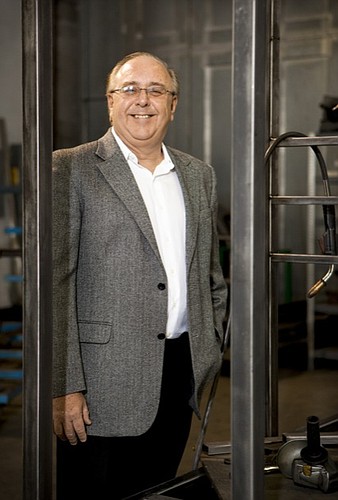One of the Review's Best Managed Companies of 2010.
REVIEW SUMMARY
Business. Crane Environmental, Venice
Industry. Manufacturing
Key. Company has mixed several management philosophies to create its own system.
Fred Grover carries the title of director of factory operations, but when he takes his daily walks of said factory floor he becomes the chief lackey.
That's because Grover, of Venice-based Crane Environmental, hears regularly about employees' complaints, dilemmas and grievances on his strolls. And then, by company dictum, he and his top executive staff have 48 hours to solve the problem, or what's internally called an “improvement opportunity.”
Crane Environmental, which makes water purification systems, is an independently run division of Stamford, Conn.-based publicly-traded Crane.
“As managers, we are responsible for taking away roadblocks,” says Grover. “We tell the staff to make it ugly so we can fix it. They don't gloss over it or sugarcoat it.”
Grover calls the strolls his daily walkabouts. The sessions are one reason why Crane Environmental, which has about 55 employees, is considered one of the top managed companies on the Gulf Coast. The company's system, a high intensity version of Lean management, has led to a 50% decrease in the average time it takes to get a project completed, Grover says.
Moreover, Crane Environmental's peers and several local trade and economic development groups have recognized the company for its management philosophies. For example, Crane Environmental won the Export Excellence Award from the Economic Development Corp. of Sarasota County last year. It was also named the EDC's Manufacturer of the Year in 2007.
For export excellence, the EDC noted that Crane Environmental ships products to more than 83 countries — every continent except Antarctica. “Everyone who works there is tasked with making sure the company runs efficiently,” says EDC President Kathy Baylis.
Crane Environmental's management systems also work on the financial side of the company. Grover says the Venice plant, in conjunction with a sister plant in suburban Philadelphia, surpassed $20 million in revenues in 2009. The parent company reported $2.2 billion in 2009 revenues, down 15% from $2.6 billion in 2008.
The percentage growth rate at Crane Environmental has flattened out in step with the recession, but Grover says 2010 already looks better in some regards. For instance, through February of this year orders for some of the company's larger water purification systems have already set an all-time first quarter record.
Grover emphasizes the financial side of the company' management system on a daily basis with employees. Says Grover, in a variation of a line he says often: “It's not good to have customers but not make a profit.”
Lean systems
Grover breathes management principles like that one. Indeed, an 8½-by-11 sheet of white paper that hangs on a cabinet above his desk carries this slogan: Improvise. Adapt. Overcome.
About three feet to the left of that sign is a stack of a dozen or so management books, including several devoted to Six Sigma. The Six Sigma philosophy, created by Motorola engineers in the early 1980s, is based on finding the system that eliminates the most errors in a manufacturing process while maintaining consistency.
Crane blends parts of Six Sigma, Lean and other systems into its own mix, simply called the Crane Business System. That process includes the walkabouts conducted by Grover. Several other aspects are designed to foster accountability and efficiency.
“It's an integration of everything that makes the business plan successful,” says Grover. “You don't put things in place just to put things in place. You put them in place to improve the business.”
A Boston native, Grover moved to the Gulf Coast in 2004 to work for Crane. He previously worked in the Northeast for a handful of other manufacturing companies, in products from brake parts to light fixtures to restaurant equipment.
Crane Environmental, meanwhile, was initially Environmental Products and it focused on manufacturing reverse osmosis equipment. Crane, which was initially founded in Chicago in 1855, bought the company in 1998.
By 2004, after Crane made a series of other acquisitions of similar water purification businesses, the Venice location was named headquarters of Crane Environmental.
The company's client base that now stretches to 83 countries is based mostly on two product lines: Reverses osmosis systems and deaerators.
A deaerator reduces free oxygen levels in boiler feed water, which in turn improves the longevity of the boiler. The company's reverse osmosis machines remove salt and other impure chemicals from industrial water systems and aquifers.
The customer list for those products is a diverse roster of resellers, dealers and end-users. It includes Bristol-Myers Squibb, Perdue Farms and the U.S. Army, for which the company has done work in Iraq. Other customers are resorts in Africa and the Caribbean.
Five whys
The heart of those products is put together in Crane Environmental's 40,000-square-foot Venice factory.
One of the essential parts of the Crane Way, however, is set up at the front door: No silos. Grover says he takes great effort to make sure all of the departments — there are 11 of them — talk to one another regularly.
The heads of those departments, also called cells, report directly to Grover. There are very few mid-level managers because they would only clog up the system.
And each employee is cross-trained. So welders know how to assemble and assemblers know how to weld. “I've even gone out to the floor and used a nail gun,” says Grover.
The factory floor itself is a stellar example of controlled chaos, with the emphasis on control. From garbage cans and water coolers to screwdrivers and hammers, everything gets a location label. Says Grover: “Everything is in its place and there is a place for everything.”
The seven specific departments that are on the factory floor are exactly alike in one way. Each one is marked off with a big bulletin board that holds anywhere from 12 to 16 clipboards filled with metrics and data. The four main categories are safety, quality, delivery and cost.
The departments that are off the factory floor, such as finance and customer service, also have a metric board. Grover and his top managers check the metrics daily and weekly, depending on what's being measured.
Still, the daily walkabouts, which are normally scheduled for 2 p.m., are where most of the company's management systems play out. Grover says he approaches each issue with the five whys.
That is, he will ask why up to five times when he encounters a problem. Many times, he says, the issue is deeper or different than what is originally being described by an employee.
“By the time you hit the fifth why, you better have an answer,” says Grover. “The most important thing is to get to the root cause.”






